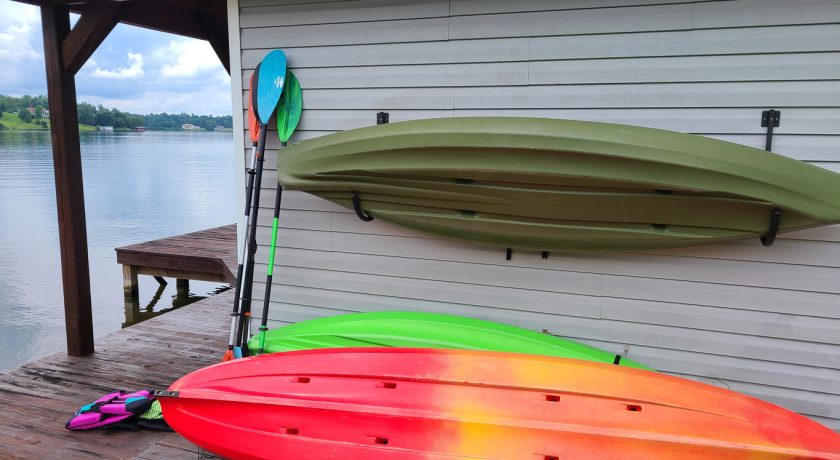Store Your Kayak the Right Way Safely

Kayaking is about freedom – gliding across open waters, exploring new environments, and exploring the outdoors. But when the paddling stops, where does your kayak go? Left outside, your kayak can fade, warp, or even crack from weather exposure. And while tossing it in the garage or leaning it against the nearest wall might seem like smooth sailing, improper storage can cause permanent damage.
At XYZ Storage, we know that storing your kayak can be quite a challenge. That’s why we’ve created this guide to help you protect and store your kayak safely whether it’s for the winter season or simply between weekend adventures.
Why You Should Store Your Kayak
Before diving into how to prepare and store your kayak safely, let’s discuss the importance of proper kayak storage. There’s a common misconception that “storing” something just means to put it out of the way. While an easy solution, simply doing that can easily lead to unnecessary damage to your belongings. Kayaks are no different – as a matter of fact, they’re even more prone to damage than most items.
That’s why it’s critical to understand the risks and the best storage methods will help keep your boat in great condition for years to come, regardless of why you’re storing away your kayak.
Temperature
Hot and cold temperatures can wreak havoc on your kayak. Direct sunlight and extreme heat can cause the hull to weaken or warp while freezing temperatures make plastics brittle and prone to cracking. While there are ways to protect your kayak against this, keeping your kayak inside is a much easier and safer solution.
UV Rays
Much like sunlight can fade and crack paint, UV rays can degrade the materials of your kayak’s hull over time. Fiberglass, plastic, and even inflatable kayaks can weaken from prolonged exposure. While sprays and covers exist to mitigate these side effects, proper storage can prevent these issues altogether.
Moisture
A damp kayak is a recipe for disaster since moisture buildup is one of the biggest threats to storing kayaks long-term. Whether it’s from rain, snow, or humidity, moisture creates the perfect breeding ground for mold and mildew. Properly storing your kayak with preventative measures or indoor storage with good ventilation, like a storage unit, can help avoid moisture build-up.
Security
A kayak isn’t just another piece of equipment – it’s an investment. Leaving your kayak out in the open makes it an easy target for pests and unauthorized individuals. If you have to store your kayak outdoors, secure it with a heavy-duty lock or chain. Even better, indoor storage in a locked garage, shed, or storage unit is the best way to keep your kayak safe from prying hands (or paws!)
Weight
How you position your kayak is just as important as where you store it. Uneven weight distribution or additional pressure points can cause dents and warp your kayak. A proper storage method, like using a kayak rack, inflatable rack, or suspension system keeps the hull evenly supported and prevents any pressure damage from occurring. If you are storing multiple kayaks, stacking them improperly can also lead to damage, so be sure to distribute their weight carefully.
Preparing Your Kayak for Storage
Now that you know why proper storage is important, it’s time to ensure your kayak is ready to be put away. Before you store your kayak away for the season, it’s important to take the right steps to protect your kayak to keep it in pristine condition. This way, your kayak will be ready for your next adventure! Remember, proper kayak storage isn’t just about finding a spot to put it – it’s about making sure your kayak doesn’t come out with any unpleasant surprises. Follow these key steps to prepare your kayak for storage:
Check the Owner’s Manual
Nobody knows your kayak better than the people who made it. Before storing your kayak, be sure to read over the Owner’s Manual for any manufacturer-specific cleaning recommendations or storage information to properly care for your kayak.
Don’t have access to the manual anymore? No worries! Most manufacturers have them online. Just search for your kayak model followed by “instruction manual,” and everything you need should be there.
Remove Any Accessories
Remove any accessories or belongings that aren’t part of the kayak itself, including seats, dry boxes, fishing gear, life jackets, etc. Not only can these items get lost or damaged, but loose objects inside your kayak can cause scratches and wear over time. The last thing you want is to pull your kayak out in the spring only to find a rusted hook or torn seat waiting for you.
Thoroughly Clean and Dry Your Kayak
A clean kayak is a happy kayak! Whether you’re storing kayaks indoors or using an outdoor setup, a proper cleaning before storage will help extend its lifespan.
Cleaning Your Kayak
If you’re a frequent paddler, a quick rinse with fresh water after every trip helps keep dirt and debris in check. However, when preparing for winter or the long term, a deep clean may be necessary.
To effectively clean your kayak, use mild soap and a soft sponge or brush to scrub down both its interior and exterior. It’s best to pay special attention to the hull and cockpit, as mud, salt, and sand love to hide in those spots. Additionally, if you’ve been padding in saltwater, be extra thorough, as salt residue can degrade both hardshell and inflatable kayaks over time.
Once you’ve thoroughly scrubbed your kayak, rinse off all remaining soap as carefully as possible to prevent streaks.
Inspecting Your Kayak
Cleaning your kayak also provides a great opportunity to inspect it for any signs of damage. Kayaks can sustain minor hull damage from bumping into rocks or other debris while in use and may go unnoticed during normal operation. While small dents or scratches may not seem serious at first, catching it now means fewer surprises when it comes time to hit the water again.
Drying Your Kayak
Never store a wet kayak as it creates an open invitation for mold, mildew, and unpleasant smells.
To start, open the drain plug (if your kayak has one) to let out any excess water. Once all of the water has been drained, let your kayak air dry in a well-ventilated area for about ten minutes. Finally, use a dry towel to wipe down all surfaces, paying close attention to hidden corners where water likes to linger to avoid moisture build-up.
By ensuring your kayak is completely dry before storage, you’ll avoid mold and keep it fresh for your next outing.
Protecting Your Kayak
A little extra care goes a long way in preserving your kayak’s condition while it’s in storage. Follow these steps to ensure your kayak is protected from unnecessary damages:
Lubricate Moving Parts
If your kayak has rudders, footrests, or other moving parts, now’s the time to give them the attention they deserve. Clean them thoroughly, removing any dirt or sand, then apply a suitable lubricant that doesn’t attract dust or grit, such as silicone lubricant spray. This prevents stiffness and rust build-up, especially if you’re planning for winter kayak storage.
Apply UV Protection
Even while in storage, sunlight can be a silent kayak killer. UV rays can cause fading, cracking, and warping over time if left unchecked. To protect your kayak against this, apply a UV guard like 303 Aerospace Protectant or a kayak-specific wax to the hull. By doing this, you can comfortably maintain the integrity of your kayak throughout the winter stress-free!
Fasten and Cover Your Kayak
Before placing your kayak into storage, make sure all straps, handles, and bungee cords are securely fastened. By doing this you can prevent any accidental damage that can occur when placing your kayak into storage.
If you have a sit-inside kayak, consider using a cockpit cover to keep out dust, critters, and debris. This is particularly useful for storing outdoors, especially since you don’t want to discover a surprise guest (cute as they may be) inside when you’re ready to hit the water again!
Where and How to Store Your Kayak Correctly
Now that your kayak is prepped and protected, it’s time for arguably the most important step – storing it the right way. Whether you’re working with indoor or outdoor storage, or need to fit multiple into a tight space, choosing the right storage method will prevent warping, weather damage, and unnecessary wear.
Outdoors: When Indoor Storage Isn’t an Option
While storing a kayak outdoors may seem like the right thing to do, unfortunately, factors like sunlight, weather, and critters all have the potential to damage your kayak over time. If storing a kayak indoors isn’t possible, consider the following before storing your kayak outside.
Keep your kayak off the ground using a kayak rack or inflatable rack, as this will prevent uneven weight distribution from warping your kayak over the season.
A UV-resistant tarp or cover protects your kayak from direct sunlight, which can also cause warping. You also want to avoid wrapping it too tightly though, as trapped moisture can become another issue altogether.
And if you plan to store it in the cold weather, winterizing your kayak helps prevent cracks from freezing temperatures. Using protectants like 303 Aerospace Protectant and a good clean can be enough to protect your kayak for the season, but be sure to check in on it regularly.
Indoors: The Best Storage Option
Indoor storage is ideal since you’ll be able to protect your kayak from the moisture, UV rays, and temperatures that outdoor storage suffers from. Having an indoor storage location, like a garage, shed, or storage unit can give you greater control over factors such as temperature, moisture, and security. If storing more than one kayak, distribute their weight evenly and avoid stacking them directly on top of each other without padding.
In addition to the benefits of indoor storage, how and where you place your kayak plays a crucial role in its longevity. Choosing the right spot, using a proper storage system, and positioning your kayak correctly will help prevent damage and make storage more efficient.
Pick the Right Spot
Typically, kayaks are stored alongside other belongings. If that’s the case, make sure that your kayak is stored at enough distance from these items to comfortably access and inspect and is not at risk of being damaged by any objects around it. The more space you have dedicated to your kayak, the better! On top of making sure your kayak has enough space surrounding it, choose a cool, dry area away from any heat sources, windows, or damp corners.
If storing your kayak outdoors, find a shaded area or use a UV-resistant cover. It’s important to also avoid places with extreme temperature changes or excessive wind, as this can make your kayak brittle over time.
Rack Storage: Simple and Reliable
A kayak rack is a great option for both indoor and outdoor storage. Racks come in various styles and sizes, ranging from wall-mounted to freestanding racks for several kayaks. They are also available in more affordable formats, like inflatable racks which go as low as $20.
When storing a kayak on a rack, be sure to always position it on its side or hull-up to prevent damage from pressure points and cover your storage rack if stored outdoors.
Suspended Storage: Maximizing Space
If space is tight, a suspension system is a great alternative. Hanging your kayak from the ceiling or wall with wide straps helps prevent pressure dents, all while keeping your kayak out of the way. Just avoid hanging it by the grab handles, as this can cause warping so we recommend you use a proper hoist system instead.
Pick the Right Position
After finding a suitable area for your kayak, the next step is to determine the best position for your kayak. Never leave it flat on its hull for long periods, as this can cause dents and warping. Instead, store it on its side, upside-down, or on a kayak rack. If hanging, use wide straps rather than grip handles to prevent bending.
Of course, having enough space is becoming increasingly difficult to make available for storage purposes. No worries though, as there are various options to securely position your kayak for both short and long-term storage.
Horizontal or Upside-Down Storage: The Stable Choice
Storing your kayak horizontally or upside-down helps prevent warping and pressure damage, especially over extended periods. If using a kayak rack, position the kayak upside-down and make sure its weight is distributed evenly across padded supports. A cradle-style rack or wide, cushioned bars work best for horizontal storage, especially when storing more than one kayak. Avoid placing your kayak flat on its hull for long periods, as this can cause deformation. With proper support, this method keeps your kayak reliably safe and secure.
Vertical Storage: The Space-Conscious Choice
Storing your kayak vertically can be a great way to save space, but it must be done correctly to prevent damage and is only recommended if horizontal or upside-down storage isn’t an option.
Position your kayak upright or against a wall with the cockpit facing out, and place padding under the stern to avoid excess pressure. This works best for short-term storage, as prolonged weight on the bow or stern can deform the kayak over time.
If you’re using vertical storage long-term, rotate the kayak occasionally to distribute the stress evenly. With proper support and a bit of effort, this can be an efficient option for tight spaces while keeping your kayak protected.
Store it Right, Paddle Anytime
Now that you have the necessary tools to safely store your kayak, you can enjoy peace of mind knowing it’s protected and ready whenever you are. Remember, a well-stored kayak means fewer headaches and more time on the water. Whether you’re storing it away for the offseason or just keeping it protected between trips, choosing the right storage method will prevent warping, cracks, and weather damage. With the right storage, your kayak will stay in top condition, free from damage, and ready to hit the water whenever adventure calls.
FAQs
Whether you’re new to kayaking or a seasoned paddler, effective storage can raise plenty of questions. To help you keep your kayak in pristine condition, we’ve answered the most common concerns about storing, maintaining, and protecting your kayak. Check out these FAQs to ensure your kayak stays safe and ready for adventure:
What are the best ways to store a kayak indoors?
One of the best ways to store your kayak indoors is a wall-mounted kayak rack, which keeps your kayak securely off of the ground and prevents any potential warping to the hull. If space is tight and circumstances allow it, a ceiling suspension system gives you the ability to hang your kayak overhead through a pulley system. For a simpler solution, a freestanding kayak rack with padded supports provides easy access without any wall or ceiling installation and can be found for as low as $50. Regardless of the option you choose, make sure you store your kayak on its side or upside down to prevent pressure damage to the hull.
Can a kayak be stored outside year-round?
As long as the proper precautions are taken, you can store your kayak outside year-round. However, it’s important to note that storing outside comes with its costs.
For instance, outdoor storage exposes the kayak to the elements, including sunlight, rain, wind, and snow. These can warp, crack, or fade the hull, potentially rendering your kayak permanently unusable. If you’re still determined to store your kayak outdoors year-round, be sure to:
- Keep it Off the Ground Using Either a Rack or Stand: This will prevent unwanted pests and moisture from entering the kayak.
- Apply a UV-Resistant Kayak Cover or 303 UV Protectant: This will prevent damage from the sun’s harmful rays–the same way humans use sunscreen to prevent skin damage.
- Remove Snow and Ice: If you’re planning on keeping the kayak stored during cold winter months, avoid allowing snow or ice to accumulate on the hull. Moisture from these can make the kayak brittle, so it’s recommended to pay close attention to this.
Whenever possible, store your kayak in a shaded or covered area, such as under a top-story deck or against a building with a tarp secured overhead. Properly supported storage and regular maintenance and inspections will extend the lifespan of your kayak, even when stored outdoors.
How do I protect my kayak from UV damage during storage?
Sunlight can fade your kayak’s colours, weaken materials, and can even cause cracks over time. To keep your kayak properly protected:
- Store in Shade: Whenever possible, store your kayak indoors or in a shaded area to minimize UV exposure.
- Use a Kayak Cover: A fitted, UV-resistant kayak cover helps block harmful rays and keeps out dust and debris.
- Apply a UV Protectant: Sprays like 303 Aerospace Protectant add an extra layer of defence against sun damage.
- Position Properly: Storing your kayak on its side or upside down reduces prolonged exposure and helps prevent warping.
Is it safe to hang a kayak by its handles?
Definitely not. While those handles are great for carrying your kayak to and from the water, they aren’t built to hold its full weight over extended lengths of time. Hanging it this way can cause warping, especially on a plastic kayak. Alternatively, go for a proper storage system like, a wall rack, freestanding rack, or ceiling storage with wide, padded straps to evenly distribute the weight. This way, your kayak stays in proper shape over the long term.
What type of rack or storage system is ideal for kayaks?
The best kayak storage system can be boiled down to one thing – even weight distribution. Without proper support, kayaks can warp over long periods, affecting their overall performance in the water. A wall-mounted rack with padded arms, a freestanding rack with padding, or a ceiling storage system using wide suspension straps are all great storage solutions. Whether it’s for the short or long term, always store your kayak on its side or upside down to avoid pressure points and provide optimal support.
Should I store my kayak flat or on its side?
The best way to store your kayak is on its side or, if possible, upside-down. Storing it flat can put unnecessary stress on the kayak’s hull, causing deformations over time. Keeping it on its side or upside down helps evenly distribute weight and reduces the risk of damage to the bottom of your kayak. Just make sure it’s supported securely with padding to prevent any accidental knocks over or indentations!
How can I prevent mold or mildew when storing a kayak?
The most important factor in the creation of mold and mildew is moisture, so making sure your kayak is completely dry while not in use is key. After each trip, thoroughly rinse and dry your kayak, paying special attention to hard-to-reach areas to prevent a build-up of mold over time. When preparing your kayak for long-term storage, clean it with a sponge and mild soap, rinse thoroughly, and dry as best you can.
Are there specific materials to avoid when storing a kayak?
Yes, certain materials can damage your kayak during storage and should be avoided. Storing your kayak near sharp or rough surfaces, such as concrete can damage your kayak if mishandled.
You also want to avoid any plastic material that can retain moisture, like plastic tarps and covers. To make sure that your kayak is free from moisture it should be stored in a dry area before using any type of cover to prevent mold and mildew from forming. Always use soft, non-abrasive materials for covering or supporting your kayak.
How often should I inspect my kayak while it’s in storage?
It’s best practice to inspect your kayak at least every few weeks, especially if it’s being stored for an extended period. Regular checks allow you to spot any potential issues, like cracks, leaks, or signs of mold–before they become detrimental to your kayak.
If you choose to store your kayak outdoors, inspections should occur even more often–around once a week, if possible.
How XYZ Storage Can Help
Struggling to find a safe place to store your kayak or dealing with unpredictable weather that makes outdoor storage risky? XYZ Storage has the perfect solution to keep your equipment secure and in great condition.
Our XYZ Storage facilities offer secure, temperature-controlled units designed to protect your belongings from heat, moisture, and damage, whether you need short-term storage or a long-term home. With locations across Toronto and the GTA, including Toronto Downtown, Toronto Midtown, Toronto West, Etobicoke, and Scarborough, we make storage convenient and accessible. You can even get 24/7 storage unit access if you request it on a case-by-case basis. Stop by any of our locations and our self-storage experts will be happy to help you find the perfect unit. Let us help you make storage simple and stress-free!











